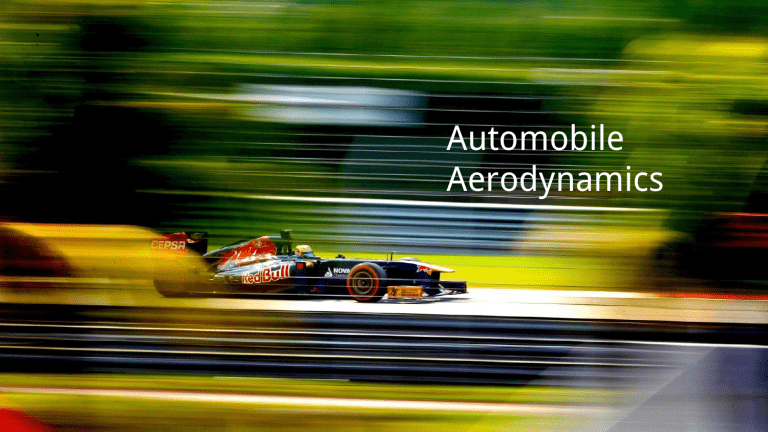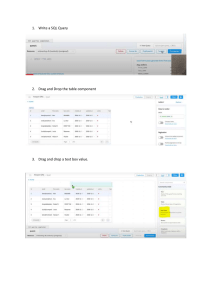
Automobile Aerodynamics Table of Contents ● Introduction ● Principles of Aerodynamics ● Historical Milestones ● Aerodynamic Components in Action ● Performance Impacts ● Case Studies ● Questions Aerodynamics is the study of the behavior of gaseous fluids as they interact with objects in motion, particularly focusing on the forces exerted on these objects. In the realm of automobile racing, where fractions of a second can determine victory or defeat, a nuanced understanding of Introduction aerodynamics is crucial for optimizing vehicle speed, stability, and fuel efficiency, thereby providing teams with a competitive edge on the track. Streamlining ● Curves associated with the fluid motion of air particles ● Attached, laminar flows are important in reducing drag & increasing downforce ● Flow separation creates unsteady wake flows and increases the drag force The Boundary Layer ● Object in motion disturbs air particles as they move around the object ● Creates an offset of air particle velocity in the space surrounding the object ● Thicker boundary layers can create more air drag ● A dramatic increase in boundary layer thickness causes flow separation (very high drag) Form Drag ● Determined by the size and shape of the vehicle body ● Can act horizontally and/or vertically ● High pressure at the front of the vehicle and low pressure above and directly behind it Skin Friction ● Determined by air resistance as the vehicle moves through it ● Acts Parallel to the body’s surface ● More favorable than form drag Primary Aerodynamic Forces ● Drag is dependent on a combination of form drag & skin friction ● Lift is produced by form drag at high speeds ● Lateral force is caused by wind moving in lateral directions or non symmetrical design Shape Optimization 1921 Tropfenwagen Prototype 1950 Porsche 356 2023 AMG 1 ● Increases in vehicle speed capabilities has required manufacturers to optimize vehicle shape ● 1920s: Prioritized reduction of form drag by narrowing the body ● 1950s: Prioritized streamlining and vehicle height ● Today: Prioritizing ground clearance & downforce Terminology Bumper Undercarriage Rear/ Back Splitter ● Optimal 4-5 inches ● High pressure area above the splitter ● Difference in air pressure generates downforce ● Streamline airflow to the undercarriage Adding a Splitter Bumper Splitter Undercarriage Rear/ Back Undercarriage ● Smoother air flow ● Consistent air pressure ● Protection against bottoming out ● Fuel efficiency ● Works in combination with the diffuser Modern cars Adding a Shield/Cover Bumper Rear/ Back Splitter Undercarriage Shield/Cover Venturi Effect Reduction in pressure as fluid passes through a constricted are and the subsequent increase in pressure as it exits into an expansion chamber Diffuser ● Generates downforce by acting as an expansion chamber ● Venturi effect ● Angle of the diffuser must be 7.5 degrees or less ● Needs significant airflow to work well ● If boundary layer separates it can create drag Adding a Diffuser Bumper Rear/ Back Splitter Undercarriage Diffuser Shield/Cover Historical Performance Impacts Case Studies The End Citations Ono, Alto. “Slipstream and ‘dirty Air’ Explained.” Racecar Engineering, 31 July 2020, www.racecar-engineering.com/tech-explained/slipstream-and-dirty-air-explained/. Roberts, Neil. “Air Dams, Splitters, Spoilers and Wings - Downforce Increases Grip, Grip Decreases Lap Times, and Isn’t That the Whole Point?” NASA Speed News Magazine, 4 Feb. 2019, nasaspeed.news/tech/aero/air-dams-splitters-spoilers-and-wings-downforce-increases-grip-grip-decrea ses-lap-times-and-isnt-that-the-whole-point/. Toet, Willem. “Willem Toet Explains....Motorsport Diffusers: Race Tech Magazine.” Race Tech Magazine |, 28 Jan. 2019, www.racetechmag.com/2017/08/willem-toet-explains-motorsport-diffusers/.

